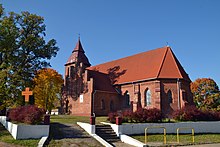Barcino
| Barcino | ||
|---|---|---|

|
|
|
| Basic data | ||
| State : | Poland | |
| Voivodeship : | Pomerania | |
| Powiat : | Slupsk | |
| Gmina : | Kępice | |
| Geographic location : | 54 ° 17 ' N , 16 ° 58' E | |
| Residents : | ||
| Postal code : | 77-232 | |
| Telephone code : | (+48) 59 | |
| License plate : | GSL | |
| Economy and Transport | ||
| Street : | DW209 Sławno - Bytów | |
| Next international airport : | Danzig | |
Barcino (German Bartin ) is a village in the municipality of Kępice ( municipality Hammermühle ) in the powiat Słupski ( district of Stolp ) in the Polish Pomeranian Voivodeship .
Geographical location and transport links
Barcino is located in Western Pomerania , about 23 kilometers south-south-west of the town of Słupsk ( Stolp ), 21 kilometers southeast of the town of Sławno ( Schlawe ) and 30 kilometers north of the town of Miastko ( Rummelsburg i. Pom. ) On voivodship road 209 from Sławno to Bytów ( Bütow ) .
history

In 1478, the Pomeranian Duke Bogislaw X. Hennes Massow, his brother Mickes and their cousins Ewald, Thomas and Claus enfeoffed the Bartin manor and other lands. With an interruption of eight years, Bartin remained in the possession of the Massow family until 1822 and is considered the ancestral home of the so-called Bartin branch of this family. In the 19th century, Bartin was the seat of the district administrator of the Rummelsburg district. In 1874 the parish village of Bartin had a farm on the Feldmark, called Kotelow or Cotlow at the time, a sheep farm, a water mill powered by the Biesternitz , a preacher, a sexton, ten farmers, two kossäts , an inn and a forge and a total of 36 households. In 1893 the manor came to members of the Puttkamer family . Then it was bought by the manor owner Karl-Wilhelm Becker. Because of the relatively large distance from the nearest cities, Bartin was given his own hospital.
In 1939 there were 1030 inhabitants in Bartin who lived in 245 households.
Before the end of World War II was Bartin seat of the administrative district Bartin in the district Rummelsburg , administrative region of Pomerania , the province of Pomerania . The parish area was 2,013 hectares. The municipality had a total of four places of residence:
- Augusthal
- Bartin
- Kotlow
- Marienthal
Before 1945 there was a train station in Bartin (on the Bütow – Zollbrück railway line ), a hospital, a pharmacy, a school, a branch of the Beßwitz electricity company, as well as various craft businesses and retail stores. The estate was last owned by the Becker family.
Towards the end of the Second World War, the village was occupied by the Soviet Army on March 8, 1945 . Several buildings had been destroyed by acts of war. The German villagers were expelled .
Today the village has about 580 inhabitants.
church
Most of the population present in Bartin before 1945 was Protestant . In 1925 there were 1017 Protestants (98.7%), seven Catholics (0.7%) and six Jews (0.6%).
Sons and daughters of the place
- Joachim Ewald von Massow (1697–1769), Prussian minister of state, war and finance as well as conducting minister for Silesia, landlord on Bartin
literature
- Ludwig Wilhelm Brüggemann : Detailed description of the current state of the Königl. Prussian Duchy of Western and Western Pomerania . Part II, Volume 2, Stettin 1784, pp. 783-784, No. 3.
Web links
- On the history of the Rummelsburg district in Pomerania: Bartin (Jürgen Lux, 2008)
- The municipality of Bartin in the former Rummelsburg district (Gunthard Stübs and Pomeranian Research Association, 2011)
Footnotes
- ^ A b Ludwig Wilhelm Brüggemann : Detailed description of the current state of the Königl. Prussian Duchy of Western and Western Pomerania . Part II, Volume 2, Stettin 1784, pp. 783-784, No. 3.
- ^ Leopold von Zedlitz-Neukirch : The Prussian State in all its relationships . Volume 2, Berlin 1836, p. 316 .
- ↑ Handbook on the Royal Prussian Court and State for the year 1841 . berlin 1841, p. 312 .
- ↑ The municipality of Bartin in the former Rummelsburg district (Gunthard Stübs and Pommersche Forschungsgemeinschaft, 2011)


